AMD Beema/Mullins Architecture & Performance Preview
by Anand Lal Shimpi on April 29, 2014 12:00 AM ESTNew Turbo Boost
With power in perspective, let’s talk about performance and the lineup. It always made little sense that despite a very competitive microarchitecture, Jaguar both consumed more power and performed worse than Intel’s Silvermont. It turns out that’s more a function of the limited time AMD’s Jaguar team had to bring the design to market. As the basis not only for AMD’s own entry level APUs but also the semi-custom SoCs bids for consoles from Microsoft and Sony, Jaguar had to be done quickly. With Puma+ and its associated SoC designs, AMD could focus more on driving power down and introducing new features, one of which happens to be a very intelligent clock boosting scheme analogous to Intel’s Turbo Boost.
While the bulk of Kabini and Temash silicon ran up to a set maximum frequency, Beema and Mullins SoCs can take advantage of available thermal headroom to increase their maximum frequency for a limited period of time. If we look at the tables below we’ll see this in action:
| Mullins vs. Temash - Frequency Gains | ||||||||
| TDP | Max CPU Frequency | Temash Equivalent | Temash Equivalent (TDP) | Temash Max CPU Frequency | Max Frequency Increase from Mullins | |||
| A10 Micro-6700T | 4.5W | 2.2GHz | A6-1450 | 8W | 1.4GHz | 57% | ||
| A4 Micro-6400T | 4.5W | 1.6GHz | A4-1250 | 9W | 1.0GHz | 60% | ||
| E1 Micro-6200T | 3.95W | 1.4GHz | A4-1200 | 3.9W | 1.0GHz | 40% | ||
AMD no longer reports max non-turbo frequency, unfortunately following in Intel’s footsteps (as well as the rest of the mobile players), but you can assume that they are mostly unchanged from Kabini/Temash. Beema and Mullins can now turbo up to much higher frequencies. In the case of Mullins in particular, since it’s so thermally constrained, the potential upside for frequency scaling is huge.
| Beema vs. Kabini - Frequency Gains | ||||||||
| TDP | Max CPU Frequency | Kabini Equivalent | Kabini Equivalent (TDP) | Kabini Max CPU Frequency | Max Frequency Increase from Beema | |||
| A6-6310 | 15W | 2.4GHz | A6-5200 | 25W | 2.0GHz | 20% | ||
| A4-6210 | 15W | 1.8GHz | A4-5000 | 15W | 1.5GHz | 20% | ||
| E2-6110 | 15W | 1.5GHz | E2-3000/E1-2500 | 15W | 1.65GHz/1.4GHz | -10%/7% | ||
| E1-6010 | 10W | 1.35GHz | E1-2100 | 9W | 1.0GHz | 35% | ||
The frequency gains aren't just limited to the CPU, the 128 GCN cores can also run at higher speeds with Beema and Mullins:
| Mullins vs. Temash - GPU Frequency Gains | ||||||||
| TDP | Max GPU Frequency | Temash Equivalent | Temash Equivalent (TDP) | Temash Max GPU Frequency | Max GPU Frequency Increase from Mullins | |||
| A10 Micro-6700T | 4.5W | 500MHz | A6-1450 | 8W | 400MHz | 25% | ||
| A4 Micro-6400T | 4.5W | 350MHz | A4-1250 | 9W | 300MHz | 16% | ||
| E1 Micro-6200T | 3.95W | 300MHz | A4-1200 | 3.9W | 225MHz | 33% | ||
| Beema vs. Kabini - GPU Frequency Gains | ||||||||
| TDP | Max GPU Frequency | Kabini Equivalent | Kabini Equivalent (TDP) | Kabini Max GPU Frequency | Max GPU Frequency Increase from Beema | |||
| A6-6310 | 15W | 800MHz | A6-5200 | 25W | 600MHz | 33% | ||
| A4-6210 | 15W | 600MHz | A4-5000 | 15W | 500MHz | 20% | ||
| E2-6110 | 15W | 500MHz | E2-3000/E1-2500 | 15W | 450/400MHz | 11%/25% | ||
| E1-6010 | 10W | 350MHz | E1-2100 | 9W | 300MHz | 16% | ||
How can AMD hit significantly higher frequencies without a substantial architecture change or new process node? By raising the max thermal operating point of the silicon. Similar to what Intel discovered in architecting its Bay Trail silicon, AMD realized that in ultra portable form factors it would run into a chassis temperature limit before it ever reached the maximum operating temperature of its silicon.
Previously once the silicon temperature hit 60C, AMD would cap max CPU/GPU frequency. However what really matters isn’t if the silicon is running warm but rather if the chassis is running too warm. With Beema and Mullins, AMD increases the silicon temperature limit to around 100C (still within physical limits) but instead relies on the surface temperature of the device to determine when to throttle back the CPU/GPU. In AMD’s own words, this allows the SoC to run at a much higher frequency for up to several minutes before having to scale back down. As long as the physical limits of the die aren’t exceeded, the design remains just as safe as before, but you get better performance.
The real trick is that AMD is able to enable this new chassis temperature governed boost (called Skin Temperature Aware Power Management - STAPM) without requiring any additional sensors or hardware from the OEM. What AMD does instead is gives the OEM tools to properly map SoC temperature to chassis skin temperature. My guess is the OEM runs a set workload, measuring external chassis temperature all while correlating that data with SoC temperature. This mapping will vary on a device by device basis, and obviously won’t be as accurate as having a thermal sensor on the chassis itself, but it’s good enough to get the job done.
AMD claims it’s intelligent about when to boost. The updated power management unit looks at the response to frequency scaling of a given workload and will only boost when the workload will actually benefit from being boosted. This evaluation happens at the hardware instruction level and not at the OS/software layer.
The Lineup
With the exception of compressing the Kabini family into four parts instead of five, AMD kept the same number of SKUs as last year but obviously with updated specs with Beema and Mullins:
| AMD Mullins vs. Temash APUs | |||||||||||
| Model | Radeon Brand | SDP | TDP | CPU Cores | CPU Clock Speed (Max) | L2 Cache | Radeon Cores | GPU Clock Speed (Max) | DDR3 Speed (Max) | ||
| A10 Micro-6700T | R6 | 2.8W | 4.5W | 4 | 2.2GHz | 2MB | 128 | 500MHz | 1333 | ||
| A4 Micro-6400T | R3 | 2.8W | 4.5W | 4 | 1.6GHz | 2MB | 128 | 350MHz | 1333 | ||
| E1 Micro-6200T | R2 | 2.8W | 3.95W | 2 | 1.4GHz | 1MB | 128 | 300MHz | 1066 | ||
| A6-1450 | HD 8250 | 8W | 4 | 1.4GHz | 2MB | 128 | 400MHz | 1066 | |||
| A4-1250 | HD 8210 | 9W | 2 | 1.0GHz | 1MB | 128 | 300MHz | 1333 | |||
| A4-1200 | HD 8180 | 3.9W | 2 | 1.0GHz | 1MB | 128 | 225MHz | 1066 | |||
The Mullins parts get a Micro prefix in front of their model number, implying the SoC's tablet-friendliness. AMD also supplies both TDP and Scenario Design Power (SDP) values for Mullins SoCs, similar to what Intel does with Bay Trail. The latter uses more tablet-like workloads (read: lighter weight) while determining SoC power.
With the exception of the entry level E1 Micro-6200T, TDPs go down substantially with Mullins vs. Temash. Cache sizes and GPU core count remain unchanged, but CPU frequencies and max DRAM frequency supported goes up in many cases.
| AMD Beema vs. Kabini APUs | |||||||||||
| Model | Radeon Brand | SDP | TDP | CPU Cores | CPU Clock Speed (Max) | L2 Cache | Radeon Cores | GPU Clock Speed (Max) | DDR3 Speed (Max) | ||
| A6-6310 | R4 | 15W | 4 | 2.4GHz | 2MB | 128 | 800MHz | 1866 | |||
| A4-6210 | R3 | 15W | 4 | 1.8GHz | 2MB | 128 | 600MHz | 1600 | |||
| E2-6110 | R2 | 15W | 4 | 1.5GHz | 2MB | 128 | 500MHz | 1600 | |||
| E1-6010 | R2 | 10W | 2 | 1.35GHz | 1MB | 128 | 350MHz | 1333 | |||
| A6-5200 | HD 8400 | 25W | 4 | 2.0GHz | 2MB | 128 | 600MHz | 1600 | |||
| A4-5000 | HD 8330 | 15W | 4 | 1.5GHz | 2MB | 128 | 500MHz | 1600 | |||
| E2-3000 | HD 8280 | 15W | 2 | 1.65GHz | 1MB | 128 | 450MHz | 1600 | |||
| E1-2500 | HD 8240 | 15W | 2 | 1.4GHz | 1MB | 128 | 400MHz | 1333 | |||
| E1-2100 | HD 8210 | 9W | 2 | 1.0GHz | 1MB | 128 | 300MHz | 1333 | |||
Beema sees the end of the lone 25W TDP for Kabini, everything is now at 15W or less. The lowest end Beema carries a slightly higher TDP than the entry level Kabini, but otherwise there's more performance at the same TDP across the board. Beema parts don't come with an SDP rating as they're designed for use in more traditional ultrathin notebook PC form factors (presumably running more traditional, read: heavier, workloads).
TrustZone
In 2012 AMD announced that it had signed a license agreement with ARM. Although we’ve since seen AMD announce ARM based Opteron silicon, back then the only official commitment was to ship an x86 SoC in 2013 with an integrated ARM Cortex A5 for TrustZone execution. AMD needed a hardware security platform on its SoCs to remain competitive, and it didn’t have one of its own (Intel’s TXT is proprietary and not a part of what’s licensed to AMD) so ARM’s TrustZone technology was an easy target. To support TrustZone you need an ARM core, and thus AMD committed to integrating a Cortex A5 as a dedicated security processor on some of its 2013 APUs.
Indeed both Kabini and Temash had a Cortex A5 on die, it was simply never enabled due to time constraints. With Beema and Mullins the core is fully functional in what AMD is calling its Platform Security Processor (PSP). AMD will likely publish guidelines on how developers can access and use the PSP, and I’d also expect to see it make its way into other AMD APUs moving forward.


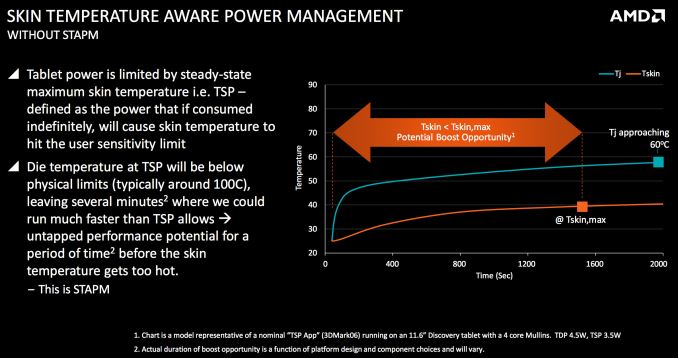
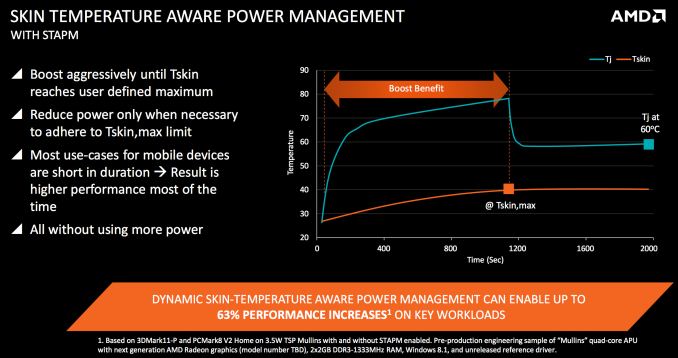
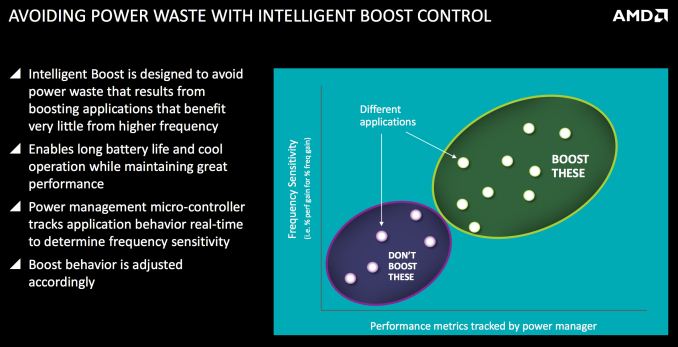
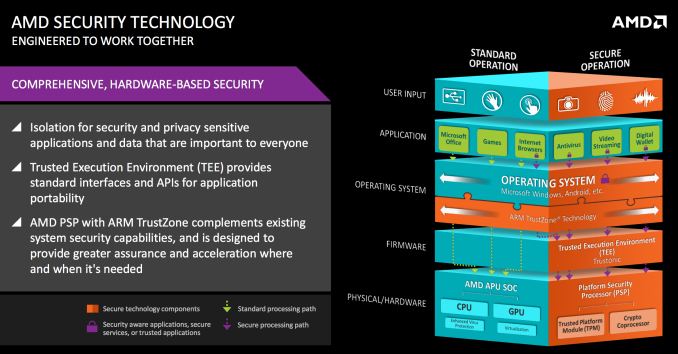
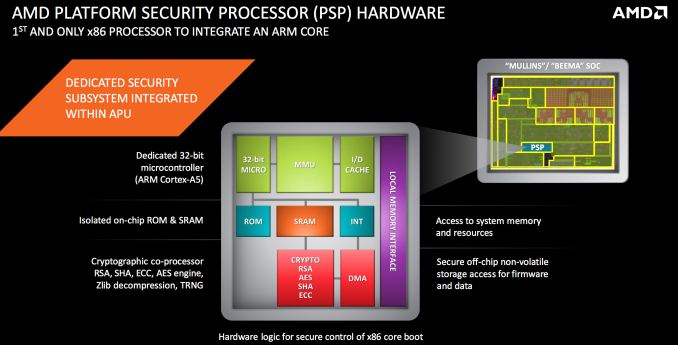








82 Comments
View All Comments
superunknown98 - Tuesday, April 29, 2014 - link
Although I don't think it would happen, or at least be publicly announced, Microsoft could use these new cores in Xbox One but could only enable turbo for the two cores that run the virtualization and Xbox OS. They would also benefit from the reduced TDP, which is something that eventually happens at some point anyway.lmcd - Thursday, May 1, 2014 - link
Now that comment on the OS and virtualization cores was quite interesting. I now thing that a Puma-edition is likely (though I think a GPU switch-up is more likely if more efficient GCN variants occur.MikeMurphy - Monday, May 26, 2014 - link
No sense revising an entire chip to save a few watts of power. They might revise it later provided that substantial power savings are attainable, otherwise will implement the usual die shrinks. Minor performance increases shouldn't be ruled out although focus will be on power reduction while maintaining similar performance.Rockmandash12 - Tuesday, April 29, 2014 - link
And this is what happens when AMD gets into gear and makes a new architecture. Real improvement that's competitive with rivals. Common.... new Desktop flagship architecture that's faster and more efficient? please?Samus - Wednesday, April 30, 2014 - link
This is pretty impressive. And honestly, out of nowhere. They all the sudden have an amazing tablet/uSFF SoC.silverblue - Tuesday, April 29, 2014 - link
Didn't Kaveri launch with a fully enabled PSP as well?Judging by the performance story thus far, I think it will put to bed the calls for cat cores to replace AMD's higher powered offerings. Yes, we're past K8 performance levels now, but Llano and Trinity (let alone Richland/Kaveri) still have it beat. You'd need some serious clock speeds to get decent performance and it's the wrong silicon for that.
I was disappointed to see that it's practically the same uarch as Jaguar, meaning we're still going to have a single channel memory controller, however the performance and power improvements are substantial, and the memory controller has been improved anyway which should reduce the need for said controller.
ET - Tuesday, April 29, 2014 - link
I think it's hard to draw conclusions of core performance when the RAM is a limitation. It's entirely possible that these cores are still pretty far from the big cores, but on the other hand it's possible that more bandwidth could up performance by quite a few percent.ssnitrousoxide - Tuesday, April 29, 2014 - link
AMD has always done some impressive work to squeeze every bit of performance from an inferior node. How they managed to improve energy efficiency so much is beyond me.mfoley93 - Wednesday, April 30, 2014 - link
It seems that most of the power reduction is at the manufacturing level; maybe it's more accurate to engineering tolerances or perhaps a more pure silicon, either way I don't think TSMC will be telling us what it is. The rest comes from eliminating circuitry that provides some more flexibility to OEMs, something nVIDIA has been doing for a couple years now, and while it doesn't reallycount, it's something Apple does very well.
yannigr - Tuesday, April 29, 2014 - link
Any idea if Beema will be compatible with existing AM1 motherboards?(with only a BIOS update of course)